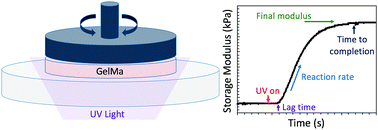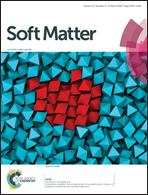Tailoring the mechanical properties of gelatin methacryloyl hydrogels through manipulation of the photocrosslinking conditions†
Abstract
Photo-crosslinkable hydrogels, in particular gelatin methacryloyl (GelMa), are gaining increasing importance in biofabrication and tissue engineering. While GelMa is often described as mechanically ‘tunable’, clear relationships linking the photocrosslinking conditions to reaction rates, and the resulting mechanical properties, have not been described. Meanwhile the conditions employed in the literature are disparate, and difficult to compare. In this work, in situ rheological measurements were used to quantify the relative rate of reaction of GelMa hydrogels with respect to light intensity, exposure time and photo-initiator concentration. In addition the UV degradation of the photo-initiator Irgacure 2959 was measured by UV-vis spectroscopy, and used to estimate the rate of free radical production as a function of light exposure. Using these data an expression was derived which predicts the mechanical properties of GelMa hydrogels produced across a wide range of crosslinking conditions. The model was validated through fabrication of a GelMa gradient which matched predicted properties. Human mesenchymal stem cells encapsulated in crosslinked GelMa exhibited high (>90%) viability post encapsulation, however metabolic activity over one week was influenced by the intensity of light used during crosslinking. The expressions described may be used to aid rational choices of GelMa photocrosslinking conditions, especially in cell encapsulation experiments where minimising the cytotoxic elements in the reaction is a priority.



 Please wait while we load your content...
Please wait while we load your content...